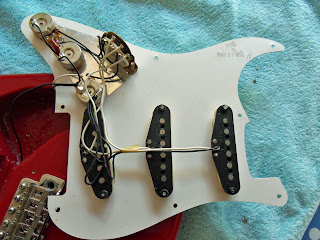I’m a bit like the cobbler’s son in as much that I fix many a guitar but my own come second place. For some time my Fender Stratocaster has been humming away to itself quite merrily. I’ve never really been bothered by it as it’s a 1950’s replica of the Made in Mexico variety (dated 25 May 1999). It is a beautifully made instrument and generally sounds good (apart from the hum) and plays very nicely. It hasn’t seen much action and so I’ve managed to keep it in pristine nick.
Anyway, it was time to change the strings and so I thought I’d do what I’ve been doing for others lately and shield it to reduce the hum as much as possible. And, wow, was it worth it. I couldn’t believe how much difference it made.
By the way, if you're on a budget a MIM Fender Stratocaster might be a good choice for you if you fancy the traditional three single coil sound. They do offer good value for money when you can't stretch to an original USA made Strat. Chris also has Vintage V6s available, which are good for Far East manufactured guitars - I've worked on these too and they are well put together for the money. He's also got some of the scarcer, Advance series Strats too, which are very nice indeed.
The first thing I do after removing the strings and cleaning up the frets and fingerboard is to check all the hardware, making sure everything is nice and tight. You’d be surprised how many guitars come my way with loose neck bolts, machine heads and so on. Mind you so long as they are loose and haven’t been over tightened, I can soon get them sorted.
Then I check the wiring to make sure all the solder joints are intact and up to the job. If not I’ll resolder any weak linkages. Noisy pots are given a second chance with a bit of cleaning and if they still sound like a bad DJ scratching, then I’ll change them for new ones. I’ll even replace the earthing wire if I don’t think it’s good enough – some guitars are poor in this respect.
Glad to say that the Strat was perfect. CTS pots and standard Fender single coils (016370) all wired neatly and tidily.
Next is sorting out the shielding. Some manufacturers and repairers use shielding paint, but I prefer to use self-adhesive copper sheet. This is very thin stuff and a pig to work with at times, but I’ve used it so much I am use to its foibles. A word of warning though, it’s razor sharp, so be careful.
I completely line the routing cavities and also let the copper overspill a bit so that it makes contact with the pickguard. However, I don’t usually cover the entire pickguard as I simply extend the existing shielding with a few strips of copper and test whether that does the job. If the pickguard is silent, then it should be fine. I did have to completely cover one pickguard for a customer, but I think that was more about the quality of the electronics than anything else. So, trial and error sometimes is worth it.
It takes me about an hour to get the job done and the guitar reassembled, but wow what a difference it makes. It surprised me as the 60-cycle hum is negligible and the pups have more edge and bite to them. Goes to show that even when the wiring is done well, there can be earthing issues. So, a revitalised Stratocaster without lashing out on new pickups – and that’s how I like things: as standard issue. I think this mod is well worth doing as it simply makes a guitar better without altering the instrument too much. Consider doing it yourself or calling in at the shop and we can sort it out for you.





